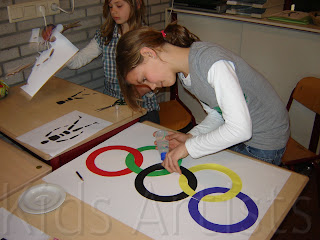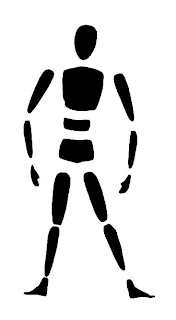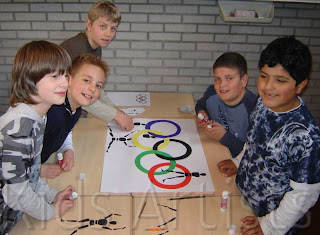You need:
- colored cardboard A3 size
- sponges
- paint rollers
- strips of ribbed cardboard
- bubble wrap
- tempera paint
- brushes
- scissors
- glue
A site with school-tested lessons for the Arts.
 Start this lesson with the symbol of the Olympics: the colored rings. What do these rings mean? What colors do they have? How are they placed together?
Start this lesson with the symbol of the Olympics: the colored rings. What do these rings mean? What colors do they have? How are they placed together?
 Ask one or two children to take the position of an athlete. What is the position of the legs, arms and body? Ask another student to show another position and discuss it again.
Ask one or two children to take the position of an athlete. What is the position of the legs, arms and body? Ask another student to show another position and discuss it again. Step two:
Every student takes a copy of the body and cuts every part of it. Then these bodyparts have to be pasted around, in, behind and in front of the Olympic rings.
Step two:
Every student takes a copy of the body and cuts every part of it. Then these bodyparts have to be pasted around, in, behind and in front of the Olympic rings.
by students of grade 3
You need:
I did this lesson in grade 5, students worked in pairs. The figures are cut before class. Per art work you need 4 black squares and 16 colored rectangles
Art Noveau was mainly applied to everyday products (for emample furniture, glassware, jewellery), in architecture, graphic art and painting. Artists were inspired by nature: patterns with birds, flowers, plants. clouds, rocks, women. Graceful moving lines express emotion.
Famous Art Nouveau artists are Alphonse Mucha, Gustav Klimt, Gaudi, Berlage.
You need:
Show pictures of Art Nouveau tiles: organic shapes of flowers and plants.
Tell students they are going to build a litte wall of tiles in Art Nouveau style. Every wall has six tiles. Flowers have to be cut out of the folding sheets. Try to use as much as possible of those sheets, so what you cut you glue on the wall.
Artworks made by students of grade 2
Benodigdheden:
Who is Matisse?
Matisse (1869 –1954) was a French artist, known for both his use of colour and his fluid and original draughtsmanship. He was primarily known as a painter.
Matisse didn't care if stones were blue, he just chose the colors he liked. Some people thought is art was very ugly: someone who paints blue faces and green noses is a fool and Matisse was called 'Fauve', which means: wild. This is how the word Fauvism came into being for this art movement, art with bold colors.
After a surgery Matisse spent the rest of his life in a wheelchair. He wasn't able to paint anymore, but could still paint with his scissors.
View various artworks of Matisse.
Source: Laatmaarleren.nl
Cut several circles from scraps of colored paper and paste them om the drawing sheet. Paste smaller circles on the bigger ones. Draw petals using several black markers in several thicknesses.
Source: Krokotak.com
You need:

artworks are made by students of grade 4
This is lesson 2 about George Braque. First lesson: click here.
You need:George Braque (1882-1962) was a French painter and sculptor. Together with Picasso he was founder of cubism.
After is cubist time, Braque painted simplified figurative paintings of landscapes and still lifes with musical instruments and bottles. Remarkable are the letters and nummers Braque added to his works.
When Braque became ill, he was no longer able to paint. He turned to making color litographs of simple bird silhouettes. The same birds you that can also be seen in one of the ceiling paintings of the Louvre in Paris.
Look at the artwork Les oiseaux of George Braque.
What do you have to do:
Draw at least three silhouettes of birds on colored paper. Cut them. Cut geometrical shapes out of paper scraps. Paste everything on the blue sheet.
